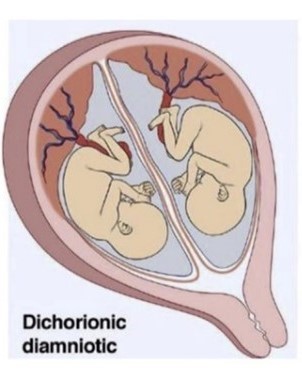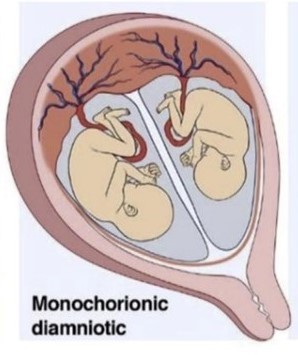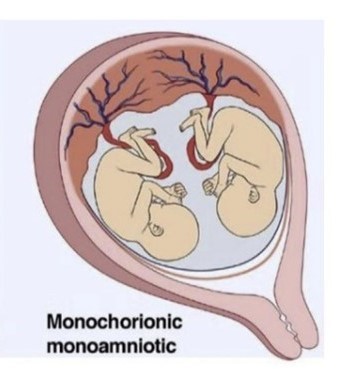Chorionicity
In the womb, a fetus (baby) grows within its mother’s uterus. The placenta attaches to the wall of the uterus and has the functions of supplying nutrients to the foetus as well as removing waste. The fetus is connected to the placenta via the umbilical cord. It sits in a fluid-filled sac that is surrounded by a thin membrane called the amnion. There is a second membrane called the chorion that surrounds the amniotic sac. The number of chorions is the same as the number of placentae of the pregnancy.
The combinations of chorion and amnion possible in a twin pregnancy are:

Di/Di (dichorionic/diamniotic)
These are twins that have separate chorions and are in their own amniotic sacs. Sometimes referred to as DCDA.
These twins can be monozygotic or dizygotic.

Mo/Di (monochorionic/diamniotic)
These are twins that are in separate amniotic sacs but contained within the same outer membrane and there is a single, shared placenta.
Sometimes referred to as MCDA. These twins will always be monozygotic.

Mo/Mo (monochorionic/monoamniotic)
These are twins that are in a single amniotic sac, with a single chorion and there is a single, shared placenta. Sometimes referred to as MCMA.
These twins will always be monozygotic.
Note there can be no Di/Mo combination – if there are two chorions, then they cannot be in the same amniotic sac since it is the innermost membrane and, by definition, they will be separated.
Parents are often told their twins are dizygotic (fraternal) because they have their own placenta and amniotic sac, however this is not always the case as some identical twins can be Di-Di.
Monozygotic (identical) twins develop from one fertilised egg which divides into two individuals who have all their genes in common (i.e. they are clones), unless a mutation occurs during development. No one knows what causes the egg to divide in half. The stage at which the zygote divides determines the chorionicity (number of placentae) and amnionicity (number of sacs):
- Dichorionic-Diamniotic (Di-Di) twins form when splitting takes place by the sixth day after conception. About 32% of identical twins are this type (some have fused placentas).
- Monochorionic-Diamniotic (Mo-Di) when splitting takes place between days six and ten. This is the most common type of identical twins at about 64%.
- Monochorionic-Monoamniotic (Mo-Mo) twins occur when the split takes place between day 10 and day 14 and only occur in 4% of identical twins.
- If the division of the zygote occurs later than 14 days and is not complete, then conjoined twins are usually the result. This type is very rare at less than 1% of identical twins.
The importance of determining zygosity and chorionicity
It is critical that the number of placentas, chorions and amnions is determined in early pregnancy by a skilled ultrasound technician. Sharing the same amnion (or the same amnion and placenta) can cause complications in pregnancy. The chorion-amnion arrangement is crucial to pregnancy management in cases of one fetal demise or selective reduction, and because of potential associated problems such as twin-twin transfusion syndrome (TTTS), growth discordance, intrauterine growth restriction (IUGR), congenital anomalies, and cord accidents. Ultrasound markers including the number of placental sites, thickness of dividing membrane, the lambda sign, and fetal gender are important in determination. Care can then be passed to maternal fetal medicine specialists as required.
Images are the property of Twins Research Australia and are used by ICOMBO with permission.